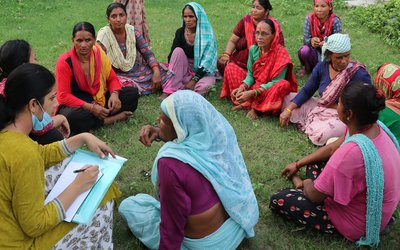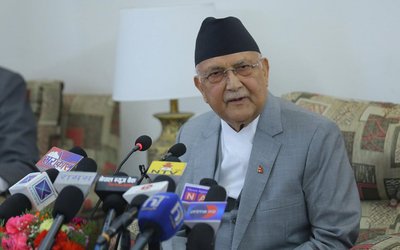
Disasters devastate Nepal’s “safe school” campaign
The recurrence of disasters has undermined Nepal’s effort to make schools safer. Indeed, Flash Report 2017-2018 suggests that about two-thirds of Nepal’s 35,601 schools are vulnerable to disasters because they are located in unsafe places close to natural hazards.
Disasters have caused much loss in and damage to Nepal’s education sector. According to the Post-Disaster Needs Assessment Report, for example, the 2015 earthquake killed 2,737 children and affected 3.2 million. It also totally damaged over 35,000 classrooms, leaving 1 million children without permanent classrooms and another 500,000 needing support to return to learning. The cost of recovery in the education sector alone was estimated at USD 397.1 million. Similarly, the 2017 floods in the southern Terai plains displaced 44,683 families and resulted in weeks-long closures of the 383 schools in the 19 affected districts that had been repurposed into temporary shelters. Besides damaging school infrastructure and disrupting teaching and learning, disasters also force children to drop out of school and undermine the resilience of local communities. While the scale of impact is not always so large as it was in these two cases, there never has been a year in which disasters have had no impact on school safety.
Safe school initiatives promise much
On the planning and programmatic front, Nepal’s safe school initiatives first emerged after the 1988 earthquake. Then, the focus was on the “hard” elements of school safety; in other words, the government repaired structural damage and developed tools and guidelines to “build back better” but made little effort to build awareness or resilience. Nepal began to incorporate disaster management in school curricula in the 1990s and 2000’s. Schools developed school safety programs and disaster management plans. The 10th periodic plan introduced safe schools and resilient education, but these issues were not prioritized for implementation until after the 2015 earthquake. Only with the 15th periodic plan (2019-2023) has the focus been on introducing disaster-resilience mechanisms to mitigate disaster-induced losses in the education sector.
For years, the Ministry of Education Science and Technology (MoEST) has been running a safe school campaign at all levels, federal, provincial and local. While it has focused on the structural dimension of seismic safety, it has also educated children about preventing, mitigating and responding to disasters and built the disaster management capacities of communities and schools. Participants have learned to prepare for and respond to possible shocks and stresses in order to ensure the continuity of teaching and learning. Other notable initiatives include JICA’s construction of earthquake-resistant school buildings (1988), the School Earthquake Safety Program (1997-1999), the American Red Cross-funded Disaster Preparedness for Safer Schools in Nepal (2009-2010), an ECHO funded child-centered disaster risk reduction (CCDRR) program (2013-2018), the World Bank funded Nepal Safer School Program under Global Program for Safer School (2015-2019), DfID-funded Nepal Safer School Project (2018-21), and the ADB-funded the Nepal School Sector Program (2011-2015).
The Joint Evaluation Report of Nepal’s School Sector Reform Plan (2009-16) emphasized the need for constructing safe and disaster-resilient school buildings, retrofitting old and dilapidated school buildings, and implementing DRR measures. It also underscored the need to make school management committees (SMCs) and communities more resilient to the impacts of natural disasters. To address the structural and non-structural dimensions of disaster risk reduction and management (DRRM) respectively, Nepal prepared safer school construction guidelines based on the National Building Code and developed the DRRM capacities of education officials and updated the terms of reference for SMCs and parent-teachers’ associations (PTAs) to include integrating DRRM activities into schools and communities. Vulnerability and capacity analysis (VCA) has helped to identify potential losses of school infrastructure and learning materials, and mainstreaming DRRM into school improvement plans has reinforced school safety. The School-Sector Development Plan (SSDP) declares that GESI principles are part of DRRM and school safety, and GESI is boosted by governmental gender-responsive budgeting.
On the policy front, 24 federal-level policies consider DRRM and school-safety issues, and the institutional landscape and policy framework are strong, particularly at the federal level. Moreover, the SSDP (2016-2023) adequately reflects disaster risks and monitors progress in implementing CSS, a globally recognized precondition to achieving quality education. The government’s safe school-related policies include the School Sector Reform Plan (2009-15), National Framework of Child-Friendly Schools (2010), Child-Friendly Schools National Framework for Quality Education (2010), Equity Strategy for the Education Sector (2011), Learn without Fear Strategy (2012), School Improvement Plan Development Guidelines (2017), draft Nepal Safe School Policy (2017), Education Act (2018), and Education Policy (2019). These policies are in line with the principles of Nepal's 2015 constitution, the SDGs and Sendai Framework for DRR and are rooted in multi-hazard risk assessment. Many toolkits, standards, and guidelines for school safety and DRRM have also been developed.
Moreover, UNICEF/USAID funded three components of Nepal’s CSS Master Plan (2017)—a minimum package, implementation guidelines, and a communication and dissemination strategy—advocate a culture of school safety and educational resilience. The National Policy for DRR (2018) and DRR National Strategic Plan of Action (2018-30) explicitly identify the aims of developing and delivering good-quality disaster-resilient and climate-adaptive education. Collectively, these policies and plans call for building new schools and retrofitting old ones, adopting soft skills related to risk management and mitigation, and mainstreaming school safety and DRR in the education sector so that local governments put resilience at the center of their efforts. Current policies include both hard and soft approaches, and focus on “DRR through education” and on resilient school infrastructure. Other issues addressed include child- and disability-friendly infrastructures and the risks that disaster and climate pose to children, schools, and communities.
Hurdles left to leap
Absence of supporting policy arms: One of the key reasons CSS campaigns are not moving forward is that there are few supporting policy arms. Schedule 8 of Nepal’s 2015 Constitution gives local governments the authority to handle safe school education by drafting laws, but they have not yet done so as the federal government has issued circulars instructing local governments not to make laws until related federal acts have been formulated.
Inadequate baseline data: Adequate baseline information on the status of safe schools or the changes in investment over the years is lacking. This dearth of data has adversely affected the targeted and optimal management and allocation of funds and resources to complete the activities of the CSS minimum package. It is not clear how many schools have benefitted from their investments in CSS.
Human and financial resource constraints
Helping 27,000 schools in 753 local levels implement CSS and then monitoring their progress is the greatest challenge the government faces. The government plans to implement safety measures in phases so that all schools meet the minimum school safety criteria by 2030, but there are currently too few technical and administrative staff to manage safe school initiatives. Budgetary constraints also negatively impact safe-school initiatives. Only about 10.93% of the total budget of Nepal was allocated to education in FY 2021/2022, with 33.38%, 2.79% and 63.82% spent respectively at the federal, provincial and local levels. In addition, DRRM gets a meagre 4.6% of the financing for the SSDP.
Low rate of policy enforcement: Many policies, tools and guidelines have been developed, but schools and governments lack the understanding and capacity to implement them, and policies often ignore structural safety issues. Some policies, like the 9th Education Act (2071), do not address disasters and climate risk, and teachers lack pedagogical support to develop resilience-building activities. Moreover, DRR curricula have not been adequately incorporated in school and college textbooks. In particular, corporal punishment and bullying have not been adequately planned for or implemented. An overarching Federal Education Act is yet to be drafted, so not only are the roles and responsibilities of each tier of government unclear but provincial and local laws are also on hold.
Inadequate stakeholders’ participation in school safety initiatives: A number of stakeholders, including schools, PTAs, SMCs, local governments, and political parties are not sufficiently active in school safety initiatives, and sometimes conflict between SMCs and PTAs directly undermines school safety initiatives. Poor community ownership, too, weakens school safety. Parents choose a school for their children based on quality of education and educational performance and accord safety standards little priority.
Domination by structural components: Despite its importance, the non-structural component of school safety is weak, a fact leaving SMCs and PTAs ill-prepared to respond to disasters. While curricula do address the types and natures of natural hazards and the problems and challenges each pose, too little learning is directed toward disaster prevention and preparedness. The DRR and safe-school messages delivered are not reinforced in formal education as school safety activities are not seen as an integral part of classroom teaching-learning but instead as additional, separate and peripheral activities that undermine the quality of “real learning.”
Safe school issues are not part of political agenda: Inadequate policy instruments and the limited capacity of local governments means that there is little focus on school safety and, as a result, on education-sector preparedness, response and resilience. Most schools do not proactively manage risk using multi-hazard assessments and thorough preventative contingency planning, nor do they have effective response plans. Another shortcoming is that DRR interventions focus only on the formal system, leaving out around 7.4% of Nepali school-aged children who are still out of school.
The march forward
Build the capacities of provincial and local governments: The capacities of SMCs and PTAs need to be built and CSS needs to be institutionalized in all seven provinces through building capacities. The capacity of provincial ministries of social development to lead and facilitate local CSS and monitor progress needs to be developed. In terms of the structural and non-structural components of safe schools, the country must use safe school construction guidelines based on the National Building Code and improve the capacities of education officials, SMCs, and PTAs. There is also a need to develop, capacitate and institutionalize a “safe school education hub” and craft clear TOR to collaborate with education clusters, working groups and CCDRR networks. All seven provinces need training centers to develop additional human resources and roll out CSS Plans, and the capacities of provincial and local governments to formulate supportive policies need to be enhanced. Other key measures include reforming and developing school disaster management plans (SDMPs) and allocating sufficient budget to implement them.
Roll out CSS campaigns by building the capacities of CSOs: Local resource persons capable of rolling out CSS campaigns in remote schools need to be groomed, and CSOs need to be sensitized and mobilized so they do not “reinvent the wheel.” The SMC Federation of Nepal, the PTA Federation, Private and Boarding Schools Organization Nepal and I/NGOs also need to be mobilized and capacitated to roll out CSS Plans. With a network of expert agencies and collaboration with CSOs and local governments, Nepal can move CSS campaigns ahead.
In addition, Nepal must implement school improvement and SDMPs, the CSS Master Plan, “DRR through schools” and disaster resilience mechanisms if it is to properly execute CSS plans. It must also adopt a mechanism to refresh knowledge and skills through training. To optimize plans, VCAs must be carried out before planning and afterwards schools must stockpile emergency materials, develop emergency evacuation plans and organize drills. Nepal must also collect and update baseline information so that it can assess value-for-money in CCS campaigns with the involvement of stakeholders and ensure that safe school issues are part of the political agenda of local governments.
Develop a CSS-funding mechanism: There is a need to establish a high-level CSS funding mechanism at the federal-level under the convenorship of the National Planning Commission and supported by federal ministries such as the MoEST, MoFAGA, MoWCSC, MoHA, MoFE, and MoUD; the education directorates/ministries of social development in the seven provinces, and representatives of the SMC Federation of Nepal and CSOs working in the education sector. The terms of reference and scope of activities of this mechanism need to be defined.
Manage knowledge: With feedback from multiple stakeholders, Nepal must develop, reform and revisit teaching-learning materials on topics like CSS and resilient schools by incorporating audio-visual aids, radio and TV programs, distance learning, and e-learning. It should also identify and document best practices and lessons learned from past CSS initiatives and use this information to revise knowledge-transfer products such as guidelines and toolkits so that they suit the new federal structure. It also needs to carry out real-time evaluations of ongoing CSS initiatives and impact evaluations of past CSS initiative so that learning is retained and knowledge is cross-fertilized. There is an urgent need to mainstream school safety and DRR in the education sector as per the mandate of SSDP (2016-2023) so that by 2030 Nepal can meet SGD 4, ‘ensure inclusive and equitable quality education and promote lifelong learning opportunities for all.’ After all, by guaranteeing school safety the fears of children, teachers and parents can be mitigated and educational performance enhanced.
Nepal has made an excellent start in making schools a danger-free zone, both physically and mentally but must not allow complacency to creep in. Much remains to be done.
(Dr. Gautam is an Independent Researcher and Consultant. He is associated with National Disaster Risk Reduction Centre (NDRC) Nepal as Senior Research Fellow and HADRI/Western Sydney University as Adjunct Fellow. He can be reached through drrgautam@gmail.com)
- The Caribbean's Climate Crisis: A Call for Urgent Action
- Mar 14, 2025
- Renewable Energy-Sector Policy Initiatives And UNDP’s Role In The Pacific Region: The Path Ahead
- Mar 04, 2024
- Operationalization Of Nepal’s National Adaptation Plan: Institutionalizing A Monitoring, Review, And Reporting System Is Crucial
- Jan 09, 2024
- Building A Pacific Region Resilient To Climate Change: A Seven Step Approach Is Urgently Required
- Jan 04, 2024
- Nepal’s DRRM Policy Landscape: Well On The Way To Making Nepal Ready And Able To Respond To Disasters
- Aug 22, 2022
















